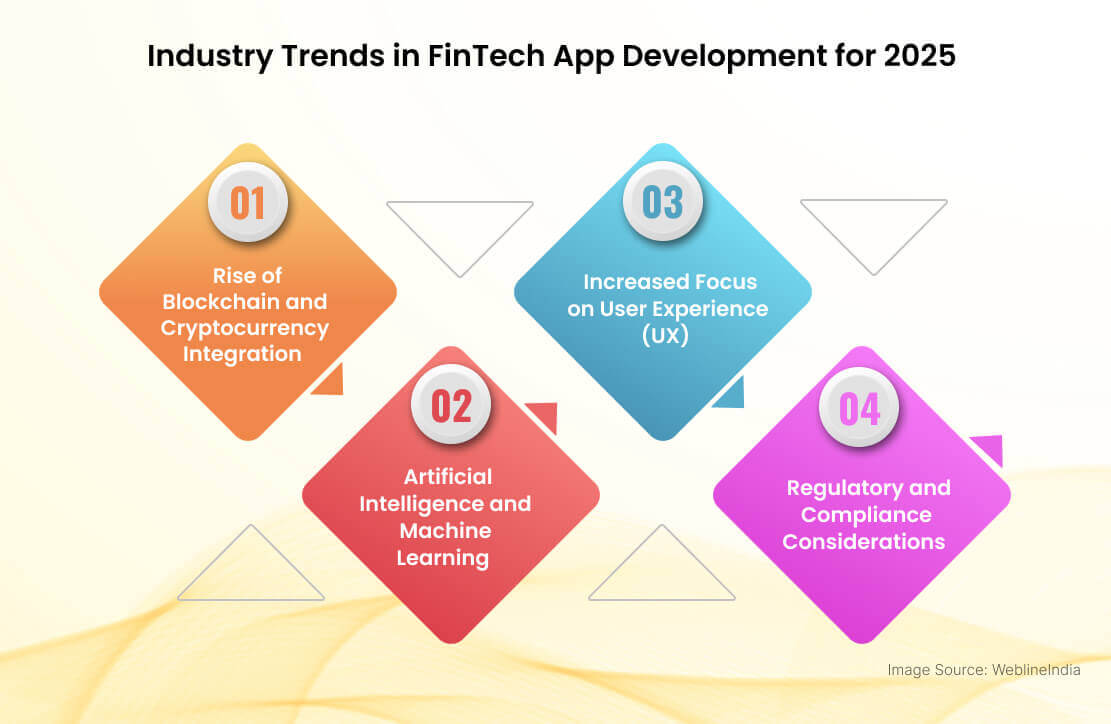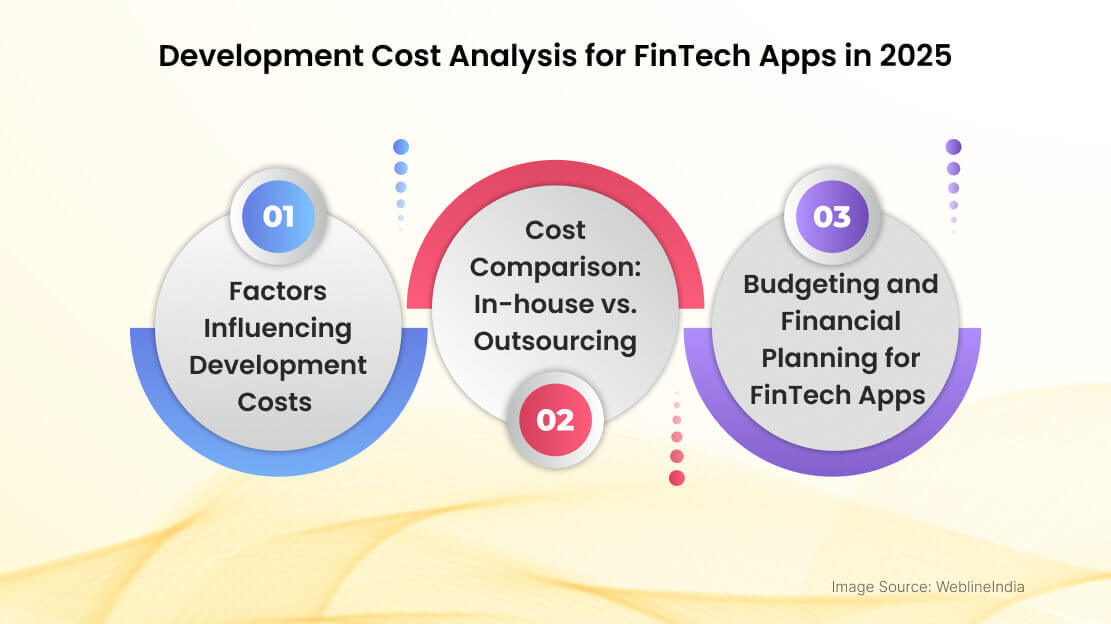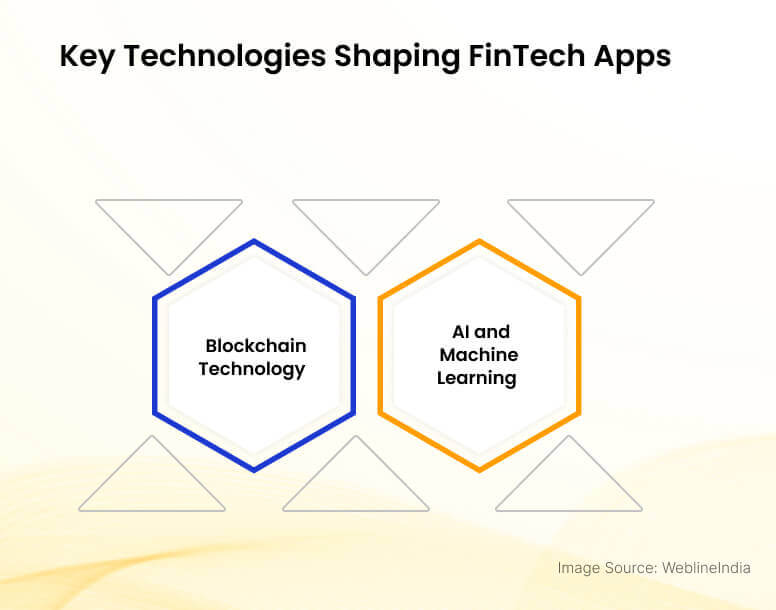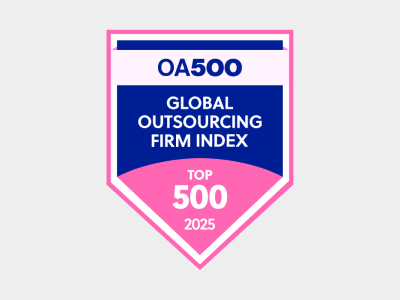The world of financial technology (FinTech) is evolving rapidly, with app development at its core. As we approach 2025, understanding the latest industry trends, statistical insights, and cost implications becomes crucial for entrepreneurs, developers, investors, and analysts.
FinTech apps are transforming how financial services are delivered, offering innovative solutions that cater to the needs of a tech-savvy consumer base. This article delves into the future of FinTech app development, highlighting key trends, statistics, cost analysis, and opportunities that will shape the industry in 2025.
Want to transform your app idea into a cutting-edge financial solution that drives innovation in 2025 and beyond?
FinTech App Development Trends for 2025 and Beyond
Rise of Blockchain and Cryptocurrency Integration
Blockchain technology is revolutionizing financial services by offering decentralized, secure, and transparent transactions. In 2025, we expect to see more FinTech apps integrating cryptocurrency features, enabling users to manage digital assets seamlessly. Blockchain’s immutable ledger is ideal for applications requiring high security, such as cross-border payments and identity verification.
Artificial Intelligence and Machine Learning
Artificial Intelligence (AI) and Machine Learning (ML) are set to enhance FinTech app functionalities by providing personalized financial advice, fraud detection, and automated customer service. AI-driven chatbots and virtual assistants are becoming standard, offering users real-time assistance and personalized recommendations. This technology not only improves customer experience but also streamlines operational efficiency.

Increased Focus on User Experience (UX)
User experience is paramount in FinTech app development, with a focus on intuitive design and seamless navigation. In 2025, UX trends will prioritize personalization, accessibility, and minimalism. Leveraging AI statistics, developers can better understand user behavior and design apps that adapt to individual preferences, ensuring a smooth and engaging experience. Enhanced UX can lead to higher user retention and satisfaction, crucial for the competitive FinTech landscape.
Regulatory and Compliance Considerations
As FinTech continues to disrupt traditional finance, regulatory bodies are introducing new compliance standards to ensure consumer protection and data privacy. Developers need to stay informed about evolving regulations and implement robust compliance frameworks within their apps. This approach not only mitigates legal risks but also builds user trust.
Statistical Insights into FinTech in 2025
Market Growth
The global FinTech market is expected to reach a staggering $305 billion by 2025, growing at a compound annual growth rate (CAGR) of around 20%. This growth is driven by increasing smartphone penetration, the rise of digital payments, and the demand for innovative financial solutions.
Investment in FinTech
Venture capital investment in FinTech startups continues to soar. By 2025, it is projected that global investment in FinTech will exceed $100 billion annually. This influx of capital will fuel innovation and the development of new FinTech applications.
User Adoption
The number of FinTech users is expected to reach 3 billion by 2025. This includes users of digital wallets, peer-to-peer payment platforms, and other FinTech services. The increasing adoption of FinTech solutions is driven by convenience, accessibility, and the growing trust in digital financial services.
Mobile Payments
Mobile payments are projected to account for 50% of all e-commerce transactions by 2025. The rise of mobile wallets and contactless payments is making cashless transactions more prevalent, especially in emerging markets.
Cryptocurrency Adoption
The global cryptocurrency market is expected to reach $4.94 billion by 2030. The increasing acceptance of cryptocurrencies as a legitimate form of payment and investment will drive the growth of FinTech apps that support crypto transactions.
Unlock the potential of FinTech in 2025 to streamline operations and captivate your users.
Development Cost Analysis for FinTech Apps in 2025
Factors Influencing Development Costs
The cost of developing a FinTech app in 2025 will depend on several factors, including design complexity, platform choice, and feature set. For businesses exploring MVP app development, starting with a minimum viable product can help reduce initial expenses while focusing on core functionalities.
Key cost components include UI/UX design, backend development, testing, and maintenance. Additionally, incorporating advanced technologies like AI and blockchain can increase development expenses but also enhance app capabilities.

Cost Comparison: In-house vs. Outsourcing
Businesses face a critical decision between in-house development and outsourcing. In-house development offers greater control and data security but can be costlier due to hiring and infrastructure expenses.
Conversely, app development outsourcing to specialized firms can reduce costs and provide access to expert talent. Each approach has its pros and cons, and firms must assess their priorities and budget constraints.
Budgeting and Financial Planning for FinTech Apps
Effective budgeting is essential for FinTech app development. Startups and enterprises should create detailed financial plans that account for initial development costs, ongoing maintenance, and marketing efforts. Allocating resources wisely ensures the sustainability and scalability of the app.
Key Technologies Shaping FinTech App Development
Blockchain Technology
Blockchain’s decentralized nature is ideal for secure transactions and data management. In 2025, its use cases in FinTech will expand beyond cryptocurrencies to include smart contracts, supply chain finance, and identity verification. Despite its benefits, challenges such as scalability and regulatory compliance must be addressed.

AI and Machine Learning
AI and ML are transforming financial services by automating processes and providing data-driven insights. In 2025, these technologies will play a crucial role in risk assessment, fraud prevention, and personalized customer experiences. Continuous advancements will enable FinTech apps to anticipate user needs and deliver tailored solutions.
Security and Risk Management in FinTech App Development
Cybersecurity Threats and Solutions
As FinTech apps handle sensitive financial data, cybersecurity is a top priority. Common threats include phishing attacks, data breaches, and malware. Developers must implement robust security measures such as encryption, multi-factor authentication, and regular security audits to protect user data and maintain trust.
Risk Management Strategies
Identifying and mitigating risks is essential for FinTech app success. Developers should conduct thorough risk assessments and establish contingency plans to address potential issues. Regular security audits and updates ensure the app remains resilient against emerging threats.
Future Outlook and Opportunities in FinTech
Emerging Markets and Expansion Opportunities
Emerging markets present significant growth opportunities for FinTech companies. With increasing smartphone penetration and a need for accessible financial services, these regions offer fertile ground for expansion. Companies should adopt localized strategies and collaborate with local partners to tap into these markets effectively.
Innovations on the Horizon
Technological innovations such as quantum computing, IoT, and 5G will influence FinTech app development in 2025. These advancements will enable faster, more secure transactions and expand the range of services offered. Staying ahead of these trends ensures competitive advantage and continued growth.
Conclusion
As we approach 2025, the FinTech app development landscape is poised for transformative changes. Understanding industry trends, consumer preferences, and cost implications is crucial for success. By leveraging emerging technologies and prioritizing security and user experience, FinTech companies can deliver innovative solutions that meet the evolving needs of consumers worldwide.
Social Hashtags
#FinTech2025 #FinTechAppDevelopment #DigitalFinance #FutureOfFinTech #FinTechTrends #FinanceTech #FinTechDevelopment #FinTechStats #FinTechSolutions #SmartFinance
Frequently Asked Questions
Looking to develop app for your FinTech business?
Testimonials: Hear It Straight From Our Global Clients
Our development processes delivers dynamic solutions to tackle business challenges, optimize costs, and drive digital transformation. Expert-backed solutions enhance client retention and online presence, with proven success stories highlighting real-world problem-solving through innovative applications. Our esteemed Worldwide clients just experienced it.
Awards and Recognitions
While delighted clients are our greatest motivation, industry recognition holds significant value. WeblineIndia has consistently led in technology, with awards and accolades reaffirming our excellence.

OA500 Global Outsourcing Firms 2025, by Outsource Accelerator

Top Software Development Company, by GoodFirms

BEST FINTECH PRODUCT SOLUTION COMPANY - 2022, by GESIA

Awarded as - TOP APP DEVELOPMENT COMPANY IN INDIA of the YEAR 2020, by SoftwareSuggest